翻译方法--直译和意译
四种翻译方法,十种翻译技巧

四种翻译方法1.直译和意译所谓直译,就是在译文语言条件许可时,在译文中既保持原文的内容,又保持原文的形式——特别指保持原文的比喻、形象和民族、地方色彩等。
每一个民族语言都有它自己的词汇、句法结构和表达方法。
当原文的思想内容与译文的表达形式有矛盾不宜采用直译法处理时,就应采用意译法。
意译要求译文能正确表达原文的内容,但可以不拘泥与原文的形式。
(张培基)应当指出,在再能确切的表达原作思想内容和不违背译文语言规范的条件下,直译有其可取之处,一方面有助于保存原著的格调,另一方面可以进新鲜的表达方法。
Literal translation refers to an adequate representation of the original. When the original coincides or almost tallies with the Chinese language in the sequence of vocabulary, in grammatical structure and rhetorical device, literal translation must be used.Free translation is also called liberal translation, which does not adhere strictly to the form or word order of the original.(郭著章)直译法是指在不违背英语文化的前提下,在英译文中完全保留汉语词语的指称意义,求得内容和形式相符的方法。
意译是指译者在受到译语社会文化差异的局限时,不得不舍弃原文的字面意义,以求疑问与原文的内容相符和主要语言功能的相似。
(陈宏薇)简单地说,直译指在译文中采用原作的的表达方法,句子结构与原句相似,但也不排除在短语层次进行某些调整。
意译指在译文中舍弃原作的表达方法,另觅同意等效的表达方法,或指对原作的句子结构进行较大的变化或调整。
浅谈英语翻译中的直译和意译

浅谈英语翻译中的直译和意译一)、Literal translation 直译(异化法foreignization )Free translation 意译(归化法domestication)英、汉两种语言在结构和语义表达方面存在着雷同和差异,翻译时有时用直译,有时用意译。
(1)、直译(Literal translation)指不仅忠实于原文内容,而且忠实于原文形式的翻译方法.直译把忠于原文内容放在第一位,把忠于原文形式放在第二位,要求在保持原文内容的前提下,力求使译文与原文在选词用字、句法结构、形象比喻及风格特征等方面尽可能趋同(无限接近)。
直译把通顺的译文形式放在第三位。
(1.1)直译的应用:(1.1.1)某些习语和短语的翻译,例如cold war 冷战hot line 热线spicy girl 辣妹black market 黑市paper tiger纸老虎Blood is thicker than water 血浓于水The heart is seen in wine. 酒后吐真言(1.1.2)含义广为流传,读者较为熟悉的短语、习语等, 直译可以丰富译语语言。
例如:A. He walked at the head of the funeral procession, and every nowand then wiped his crocodile tears with a big handkerchief.他走在送葬队伍的前头,还不时用一条大手绢抹去那鳄鱼的眼泪。
B. The Senate Foreign Relations Committee today extended the olivebranch to the Clinton Government by pleading for cooperation indeveloping foreign policy.参议院外交委员会今天向克林顿政府伸出了橄榄枝,要求在发展外交政策上合作。
翻译方法--直译和意译..
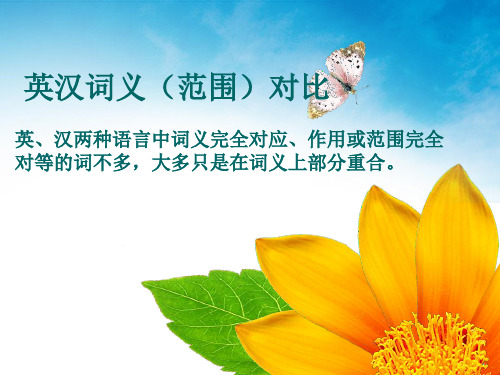
1. 你越是努力学习英语,你说英语就会越好。 The harder you study English, the better you speak it. 2. 据说他一直学英语。 He is said to have been studying English./ It is said that he has been studying English. 3. 他要在美国学习的愿望是可以理解的。 His wish to study in America is quite understandable./ It is quite understandable that he wishes to study in America.
Book -- 书
1. The company’s books are audited every year. 这家公司的账目每年都核对。 2. He is to swear on the Book before taking office. 他上任前将手按圣经宣誓。 3. 她家世代书香。 She comes from a long line of scholars. 4. 家书抵万金。 A letter from home is worth ten thousand pieces of gold.
4. 部分英语词汇的涵义范围比相应的汉语词汇既 宽广又狭窄。 e.g. Make---做
1) What you said just now does not make sense. 你刚才说的话没有意义。 2) She makes her living as a designer. 她当设计师以维持生计。 3)这次我做东。It is my treat today. 4)外国科学家做到的,中国科学家一定能够做到, 而且能做得更好。 What foreign scientists have accomplished, Chinese scientists can also accomplish, and can even do better job of it.
第三章翻译方法+直译与意译
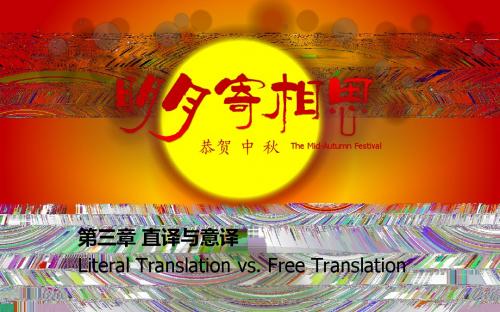
The Mid-Autumn Festival
译文 他们口惠实不至,口口声声支持教育,却又不肯为改善学 校条件而作些实际工作。 分析 pay lip-service 指说得好听而实际上却没有诚意的许诺, 即口惠。因此,决不可把“pay lip-service”直译成“支付口头服 务” 这样的生硬说法。句子的后一部分but don’t work for better school直接直译就可以了。
The Mid-Autumn Festival
恭 贺 中 秋
(11) 过度授权与地方权力滥用一直是中国历史上突出的两大问题。
译文 Excessive power and abuse of authority at local levels have been two major problems throughout Chinese history. 分析 Here there is very little room for flexibility, and the translator has followed the original closely, more or less word for word.
(9)他的姿势不大寻常,头朝下,两腿高举在沙发上,倒竖蜻蜓。 译文 He was doing this in a quite unusual posture, holding his body upside down and his legs straight up against the back of his chair, like a gymnast performing a headstand. 评析 A strict translation would render 倒竖蜻蜓 “upside-down dragonfly” which is inappropriate, since the analogy is not a common one in English.
直译法和意译法
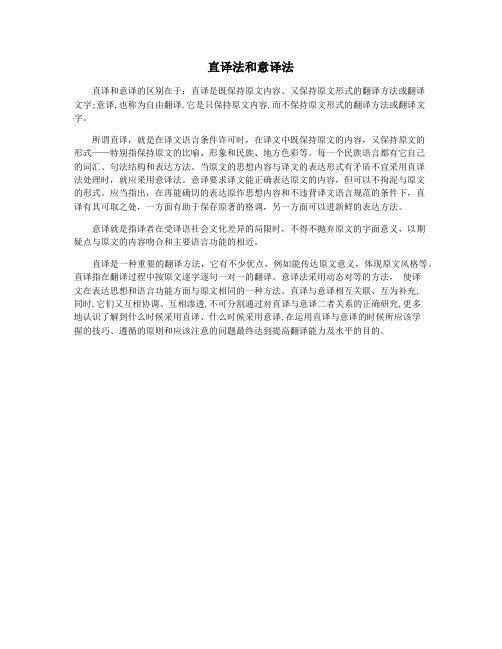
直译法和意译法
直译和意译的区别在于:直译是既保持原文内容、又保持原文形式的翻译方法或翻译
文字;意译,也称为自由翻译,它是只保持原文内容,而不保持原文形式的翻译方法或翻译文字。
所谓直译,就是在译文语言条件许可时,在译文中既保持原文的内容,又保持原文的
形式——特别指保持原文的比喻、形象和民族、地方色彩等。
每一个民族语言都有它自己
的词汇、句法结构和表达方法。
当原文的思想内容与译文的表达形式有矛盾不宜采用直译
法处理时,就应采用意译法。
意译要求译文能正确表达原文的内容,但可以不拘泥与原文
的形式。
应当指出,在再能确切的表达原作思想内容和不违背译文语言规范的条件下,直
译有其可取之处,一方面有助于保存原著的格调,另一方面可以进新鲜的表达方法。
意译就是指译者在受译语社会文化差异的局限时,不得不抛弃原文的字面意义,以期
疑点与原文的内容吻合和主要语言功能的相近。
直译是一种重要的翻译方法,它有不少优点,例如能传达原文意义,体现原文风格等。
直译指在翻译过程中按原文逐字逐句一对一的翻译。
意译法采用动态对等的方法,使译
文在表达思想和语言功能方面与原文相同的一种方法。
直译与意译相互关联、互为补充,
同时,它们又互相协调、互相渗透,不可分割通过对直译与意译二者关系的正确研究,更多
地认识了解到什么时候采用直译、什么时候采用意译,在运用直译与意译的时候所应该学
握的技巧、遵循的原则和应该注意的问题最终达到提高翻译能力及水平的目的。
翻译概论翻译直译和意译
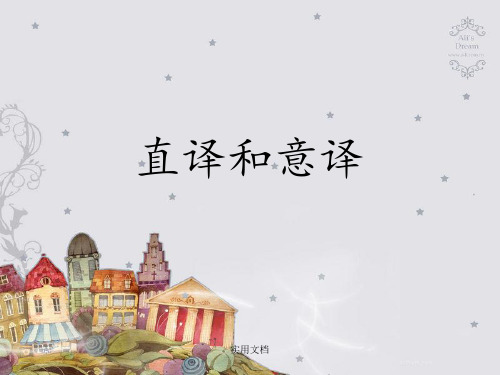
实用文档
含义广为流传的短语、习语
• 1) He walked at the head of the funeral procession,
extended the olive branch to the Clinton Government
by pleading for cooperation in developing foreign policy.
参议院外交委员会今天向克林顿政府伸出了橄榄枝,要求 在发展外交政策上合作。
实用文档
英语句子结构与中文较为接近时
实用文档
三)直译和死译的区别
(1)It was an old and ragged moon. 死译:那是一个又老又破的月亮。 直译:这是一弯下弦残月。
(2)好是很好,可是买这么多扇子干什 呀?
死译:Good is very good, but buy so many fans do what?
直译: It is good, but why do you buy so many fans?
and every now and then wiped his crocodile tears
with a big handkerchief. 他走在送葬队伍的前头,还不时用一条大手绢抹去那鳄鱼
的眼泪。
• 2) The Senate Foreign Relations Committee today
直译和意译
实用文档
定义和运用和示例 意译的功能和示例 意译和直译的对比和 统一
四种翻译方法,十种翻译技巧

四种翻译方法1.直译和意译所谓直译,就是在译文语言条件许可时,在译文中既保持原文的内容,又保持原文的形式——特别指保持原文的比喻、形象和民族、地方色彩等。
每一个民族语言都有它自己的词汇、句法结构和表达方法。
当原文的思想内容与译文的表达形式有矛盾不宜采用直译法处理时,就应采用意译法。
意译要求译文能正确表达原文的内容,但可以不拘泥与原文的形式。
(张培基)应当指出,在再能确切的表达原作思想内容和不违背译文语言规范的条件下,直译有其可取之处,一方面有助于保存原著的格调,另一方面可以进新鲜的表达方法。
Literal translation refers to an adequate representation of the original. When the original coincides or almost tallies with the Chinese language in the sequence of vocabulary, in grammatical structure and rhetorical device, literal translation must be used.Free translation is also called liberal translation, which does not adhere strictly to the form or word order of the original.(郭著章)直译法是指在不违背英语文化的前提下,在英译文中完全保留汉语词语的指称意义,求得内容和形式相符的方法。
意译是指译者在受到译语社会文化差异的局限时,不得不舍弃原文的字面意义,以求疑问与原文的内容相符和主要语言功能的相似。
(陈宏薇)简单地说,直译指在译文中采用原作的的表达方法,句子结构与原句相似,但也不排除在短语层次进行某些调整。
意译指在译文中舍弃原作的表达方法,另觅同意等效的表达方法,或指对原作的句子结构进行较大的变化或调整。
浅谈英语翻译中的直译和意译
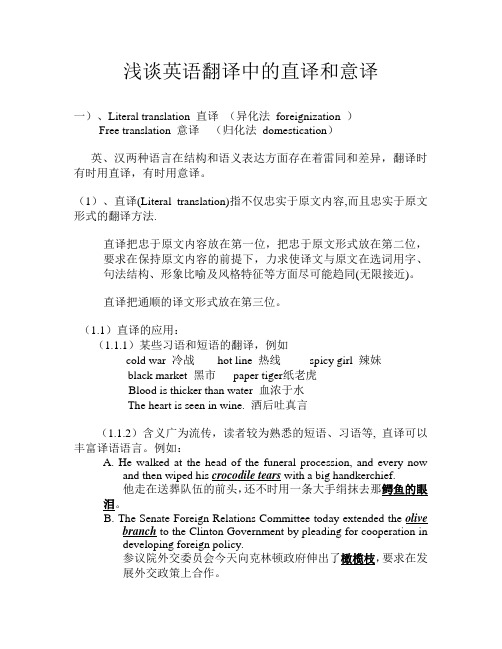
浅谈英语翻译中的直译和意译一)、Literal translation 直译(异化法foreignization )Free translation 意译(归化法domestication)英、汉两种语言在结构和语义表达方面存在着雷同和差异,翻译时有时用直译,有时用意译。
(1)、直译(Literal translation)指不仅忠实于原文内容,而且忠实于原文形式的翻译方法.直译把忠于原文内容放在第一位,把忠于原文形式放在第二位,要求在保持原文内容的前提下,力求使译文与原文在选词用字、句法结构、形象比喻及风格特征等方面尽可能趋同(无限接近)。
直译把通顺的译文形式放在第三位。
(1.1)直译的应用:(1.1.1)某些习语和短语的翻译,例如cold war 冷战hot line 热线spicy girl 辣妹black market 黑市paper tiger纸老虎Blood is thicker than water 血浓于水The heart is seen in wine. 酒后吐真言(1.1.2)含义广为流传,读者较为熟悉的短语、习语等, 直译可以丰富译语语言。
例如:A. He walked at the head of the funeral procession, and every nowand then wiped his crocodile tears with a big handkerchief.他走在送葬队伍的前头,还不时用一条大手绢抹去那鳄鱼的眼泪。
B. The Senate Foreign Relations Committee today extended the olivebranch to the Clinton Government by pleading for cooperation indeveloping foreign policy.参议院外交委员会今天向克林顿政府伸出了橄榄枝,要求在发展外交政策上合作。
- 1、下载文档前请自行甄别文档内容的完整性,平台不提供额外的编辑、内容补充、找答案等附加服务。
- 2、"仅部分预览"的文档,不可在线预览部分如存在完整性等问题,可反馈申请退款(可完整预览的文档不适用该条件!)。
- 3、如文档侵犯您的权益,请联系客服反馈,我们会尽快为您处理(人工客服工作时间:9:00-18:30)。
意译决不是妄加删改,添油加醋的胡译,乱译. 1.It rains cats and dogs. 雨下得很大. 2.我就是跳进黄河也洗不清. It can't make me clean even if I jump into the Yellow River. Nothing could bring back my innocence. 3.Criminals must be made to see the consequences of their crimes. "An eye for eye and a tooth for tooth " is the very basis of Justice. 直译:必须使罪犯看到自己犯罪的结果,"以眼还眼, 以牙还牙"正是法制的基础. 意译:必须使罪犯看到自己犯罪的结果,"以其人之道 还治其人之身"正是法制的基础.
我走在厚厚的地毯上,一点脚步声也没有.
3. You should not despise him because 看不起他. 4. Reports of new successes keep pouring in. 捷报频传 5. He sold hard-to-get items. 他兜售紧俏商品.
1. 你越是努力学习英语,你说英语就会越好. The harder you study English, the better you speak it. 2. 据说他一直学英语. He is said to have been studying English./ It is said that he has been studying English. 3. 他要在美国学习的愿望是可以理解的. His wish to study in America is quite understandable./ It is quite understandable that he wishes to study in America.
意译 free translation: 指忠实于原文内容而不拘泥 于原文结构形式与修辞手法的翻译方法.由于不同 民族在历史渊源,文化传统,风俗习惯,地理环境 等诸多方面的差异,其语言不仅在词语结构上,而 且在表达方式上也必然存在许多不同之处. e.g. 进退维谷 between the devil and the deep blue sea 画蛇添足 carry coals to Newcastle 我不知道他葫芦里卖的是啥药? I don't know what he has got up in his sleeve.
He looks at everything through colored spectacles. 他戴着有色眼镜看事物. He is a wolf in sheep's clothing. 他是一只披着羊皮的狼. 眼见为实 Seeing is believing. 别相信他,他是个大坏蛋. Don't trust him, he is a bad egg.
英汉词义(范围) 英汉词义(范围)对比
英,汉两种语言中词义完全对应,作用或范围完全 汉两种语言中词义完全对应, 对等的词不多,大多只是在词义上部分重合. 对等的词不多,大多只是在词义上部分重合.
1. 部分英语词汇的涵义范围比相应的汉语词汇宽泛. e.g. Stand---站/立 1) A tall poplar tree once stood here. 这儿曾经有一棵高大的白杨树. 2) The house has stood idle for months. 那所房子闲置了几个月了. 3) The clock stands at ten to eight. 那个钟上的时间是7点50分.
翻译的过程:正确理解→妥帖表达→细致校核 一,正确理解 1.确切理解有关单词的意义.对比较难以理解 的单词,先判断词性,在利用各种语境线索 (上下文关系,搭配关系,逻辑关系等)确定词义. 1)This idea sounds good, but will it work in practice? 这个主意听起来不错,但实际上行得通吗? 2)People from all works of life expressed their great respect to our soldiers because they are the loveliest people in the world. 各行各业的人向战士们表达了崇高的敬意,因为 他们是世界上最可爱的人.
两种语言间的差异就决定了英汉翻译中不可能 始终采用直译.否则,往往只能硬译,译文生 硬别扭甚至背离原意.在这种情况下,就须借 助于意译,摆脱原文结构形式和表达方式的束 缚,充分传达原文的意义.本质上,意译强调 "神似". As timid as a hare 胆小如鼠 To look for a needle in a haystack 海底捞针 To laugh off one's head 笑掉大牙 The apple of one's eye 掌上明珠 Put the cart before the horse 本末倒置 Cash crops 经济作物 Small profits but quick returns 薄利多销 Technical know-how 技术知识
3. 部分英语词汇的涵义范围比相应的汉语词汇狭窄. e.g. eat--吃 吃药 take medicine 吃回扣 get commission 吃惊 be amazed 吃香 be popular 吃苦 bear hardships 吃老本 live off one's past gains 万--- ten thousand 万众 millions of people 万物 all things on the earth 万幸 very lucky 万全之策 a completely safe plan 万事开头难 The first step is always difficult.
2.弄清句子结构,明辨语法关系 1) Less visible, but probably more important, are the thousands of ways industry has put electric energy to work. 工业中使用电能的多种途径虽然不是很明显,但可能 是很重要的. 2) Love is like warm sunlight, which will not only bring joy to those who are loved but also add more pleasure to those who love. 爱犹如温暖的阳光,它不仅会给被爱的人带来快乐, 也会给爱他的人带来更多的快乐.
二,妥帖表达:表达时从整体着眼,从细节入手, 避免表达过度或不足.遵循译文语言的表达习惯, 避免翻译腔. 1. For me personally, it was a blessing in disguise.
这就我个人而言,是祸中得福.
2. The thick carpet killed the sound of my footsteps.
直译决不是生搬硬套,对号入座的硬译,死译. lie on one's back black tea bull's eye the Milky Way talk horse 仰卧 红茶 靶心 银河 吹牛
直译与死译Literal Translation and Stiff Translation 1. 橱窗里摆着的是什么东西? Shop window in displayed is what thing? What's that in the shop window? 2. 来就来,可是买这么多水果干什么呀? Come just come, but buy so many fruits do what? You are so kind to bring so many fruits here, thank you. 3. I have read your articles. I expected to meet an older man. 我读过你的文章,我期望见到一位更老的人. 我读过你的文章,想不到你这么年轻.
Book -- 书 1. The company's books are audited every year. 这家公司的账目每年都核对. 2. He is to swear on the Book before taking office. 他上任前将手按圣经宣誓. 3. 她家世代书香. She comes from a long line of scholars. 4. 家书抵万金. A letter from home is worth ten thousand pieces of gold.
1. Good medicine is bitter in the mouth. 良药苦口. 2. Born with a silver spoon in his mouth, Tom is really a luck dog. 汤姆生在富贵人家,真是个幸运儿. 3. It is now thought that the more work we give our brains, the more work they are able to do. 现在人们认为,脑筋越用越灵活.
4. 部分英语词汇的涵义范围比相应的汉语词汇既 宽广又狭窄. e.g. Make---做 1) What you said just now does not make sense. 你刚才说的话没有意义. 2) She makes her living as a designer. 她当设计师以维持生计. 3)这次我做东.It is my treat today. 4)外国科学家做到的,中国科学家一定能够做到, 而且能做得更好. What foreign scientists have accomplished, Chinese scientists can also accomplish, and can even do better job of it.
